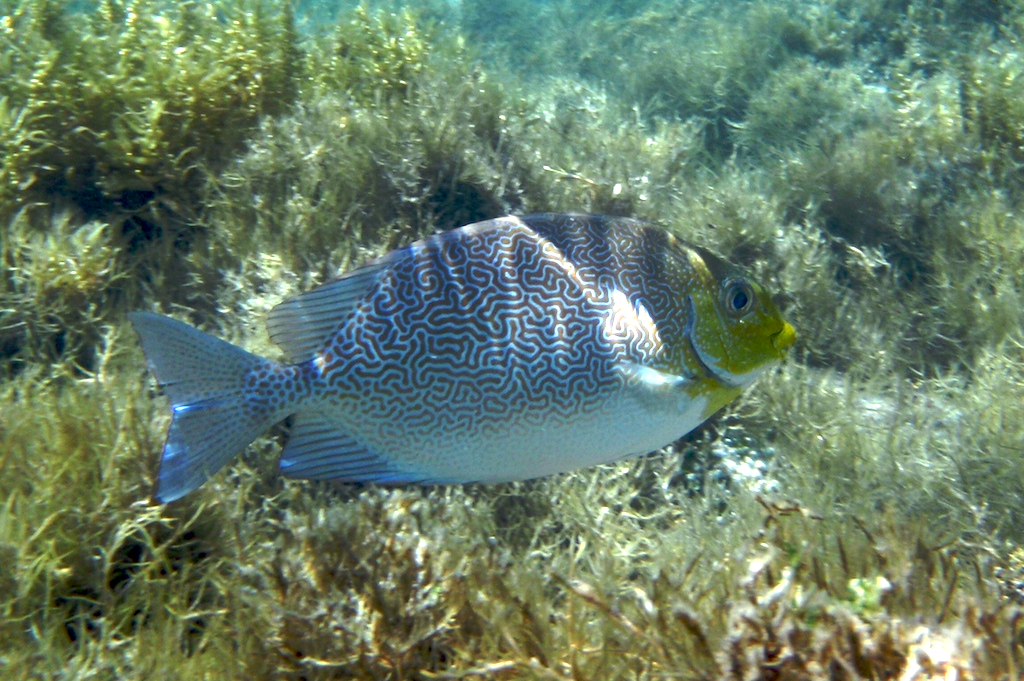- Classification
- ACTINOPTERYGII
- PERCIFORMES
- SIGANIDAE
- Siganus
- vermiculatus
Maze Rabbitfish, Siganus vermiculatus (Valenciennes 1835)
Other Names: Maze Rabbit-fish, Scribbled Spinefoot, Vermiculate Rabbitfish, Vermiculate Spinefoot, Vermiculated Spinefoot

A Maze Rabbitfish, Siganus vermiculatus, at Navini Island, Fiji. Source: Steve L. Martin / Flickr. License: CC BY Attribution
Summary:
A rabbitfish with a complex maze-like grey and whitish pattern on the body, yellow on the head and a spotted caudal fin.
Cite this page as:
Bray, D.J. 2018, Siganus vermiculatus in Fishes of Australia, accessed 10 Jul 2025, https://fishesofaustralia.net.au/home/species/1888
Maze Rabbitfish, Siganus vermiculatus (Valenciennes 1835)
More Info
|
Distribution |
Recorded from Darnley Island and possibly Townsville, Queensland, however the presence of this species in Australia is uncertain. The Maze Rabbitfish occurs in the tropical, east-Indo-west Pacific. Inhabits shallow coastal marine and estuarine waters, with a preference for estuaries. Juveniles and adults mostly occur in shallow, murky waters among mangroves, moving in and out with the tides. Adults are sometimes seen in clear waters near reefs or over sandy areas. |
|
Features |
Dorsal fin XIII, 10; Anal fin VII, 9; Pectoral fin 16-17; Vertebrae: 13. Preopercular angle 91°-102°; strong overlapping scales cover cheeks; midline of thorax scaled, not pelvic ridges. Anterior nostril with low flange, broadened slightly posteriorly. Spines stout, blunt or pungent, and venomous. |
|
Feeding |
Herbivore - mostly grazes on algae and mangrove roots. |
|
Fisheries |
Marketed fresh for 'premium market prices' in Fiji, Sri Lanka and India, as it is a large fast-growing species. |
|
Species Citation |
Amphacanthus vermiculatus Valenciennes, 1835, Histoire Naturelle des Poissons 10: 126. Type locality: New Guinea. |
|
Author |
Bray, D.J. 2018 |
|
Resources |
Maze Rabbitfish, Siganus vermiculatus (Valenciennes 1835)
References
Allen, G.R. 1991. Field guide to the freshwater fishes of New Guinea. Christensen Research Institute, Madang, Papua New Guinea.
Allen, G.R. 1997. Marine Fishes of Tropical Australia and South-east Asia. Perth : Western Australian Museum 292 pp. 106 pls.
Allen, G.R. & Erdmann, M.V. 2012. Reef fishes of the East Indies. Perth : Tropical Reef Research 3 vols, 1260 pp.
Grant, E.M. 1975. Guide to Fishes. Brisbane : Queensland Government, Co-ordinator General’s Department 640 pp.
Gunderman, N., Popper D.M. & Lichatowich T. 1983. Biology and life cycle of Siganus vermiculatus (Siganidae, Pisces). Pacific Science 37: 165-180.
Kuiter, R.H. 1992. Tropical Reef-Fishes of the Western Pacific, Indonesia and Adjacent Waters. Jakarta : PT Gramedia Pustaka Utama 314 pp. pls.
Kuiter, R.H. & Debelius, H. 2001. Surgeonfishes, Rabbitfishes and Their Relatives. A comprehensive guide to Acanthuroidei. Chorleywood, U.K. : TMC Publishing 208 pp.
Larson, H. 2012. Siganus vermiculatus. The IUCN Red List of Threatened Species. Version 2014.3.
Randall, J.E., Allen, G.R. & Steene, R. 1997. Fishes of the Great Barrier Reef and Coral Sea. Bathurst : Crawford House Press 557 pp. figs.
Valenciennes, A. in Cuvier, G.L. & Valenciennes, A. 1835. Histoire Naturelle des Poissons. Paris : Levrault Vol. 10 482 pp. pls 280-306.
Woodland, D.J. 1990. Revision of the fish family Siganidae with descriptions of two new species and comments on distribution and biology. Indo-Pacific Fishes 19: 1-136 figs 1-23, 11 pls






